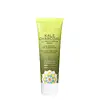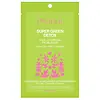What's inside
What's inside
 Key Ingredients
Key Ingredients

 Benefits
Benefits

 Concerns
Concerns

 Ingredients Side-by-side
Ingredients Side-by-side

Water
Skin ConditioningKaolin
AbrasiveBentonite
AbsorbentGlycerin
HumectantEpilobium Angustifolium Leaf Extract
Skin ConditioningCharcoal
AbrasiveBrassica Oleracea Acephala Leaf Extract
HumectantCamellia Sinensis Extract
AntioxidantXanthan Gum
EmulsifyingAloe Barbadensis Leaf Juice
Skin ConditioningPotassium Sorbate
PreservativeMoringa Oleifera Seed Oil
EmollientUndaria Pinnatifida Extract
Skin ConditioningFucus Vesiculosus Extract
EmollientCucumis Sativus Fruit Extract
EmollientPanthenol
Skin ConditioningMethyl Lactate
PerfumingPhenoxyethanol
PreservativeEthylhexylglycerin
Skin ConditioningParfum
MaskingWater, Kaolin, Bentonite, Glycerin, Epilobium Angustifolium Leaf Extract, Charcoal, Brassica Oleracea Acephala Leaf Extract, Camellia Sinensis Extract, Xanthan Gum, Aloe Barbadensis Leaf Juice, Potassium Sorbate, Moringa Oleifera Seed Oil, Undaria Pinnatifida Extract, Fucus Vesiculosus Extract, Cucumis Sativus Fruit Extract, Panthenol, Methyl Lactate, Phenoxyethanol, Ethylhexylglycerin, Parfum
Water
Skin ConditioningGlycerin
HumectantXanthan Gum
EmulsifyingSodium Hyaluronate
HumectantAscorbic Acid
AntioxidantPunica Granatum Extract
AstringentCamellia Oleifera Leaf Extract
AstringentBrassica Oleracea Acephala Sprout Extract
AntioxidantCharcoal Powder
AbrasiveCitric Acid
BufferingCoriandrum Sativum Extract
Skin ConditioningMacrocystis Pyrifera Extract
Skin ConditioningChamomilla Recutita Flower Extract
MaskingSodium Hydroxide
BufferingPhenoxyethanol
PreservativeEthylhexylglycerin
Skin ConditioningCurcuma Longa Root Extract
MaskingParfum
MaskingWater, Glycerin, Xanthan Gum, Sodium Hyaluronate, Ascorbic Acid, Punica Granatum Extract, Camellia Oleifera Leaf Extract, Brassica Oleracea Acephala Sprout Extract, Charcoal Powder, Citric Acid, Coriandrum Sativum Extract, Macrocystis Pyrifera Extract, Chamomilla Recutita Flower Extract, Sodium Hydroxide, Phenoxyethanol, Ethylhexylglycerin, Curcuma Longa Root Extract, Parfum
 Reviews
Reviews

Ingredients Explained
These ingredients are found in both products.
Ingredients higher up in an ingredient list are typically present in a larger amount.
Ethylhexylglycerin (we can't pronounce this either) is commonly used as a preservative and skin softener. It is derived from glyceryl.
You might see Ethylhexylglycerin often paired with other preservatives such as phenoxyethanol. Ethylhexylglycerin has been found to increase the effectiveness of these other preservatives.
Glycerin is already naturally found in your skin. It helps moisturize and protect your skin.
A study from 2016 found glycerin to be more effective as a humectant than AHAs and hyaluronic acid.
As a humectant, it helps the skin stay hydrated by pulling moisture to your skin. The low molecular weight of glycerin allows it to pull moisture into the deeper layers of your skin.
Hydrated skin improves your skin barrier; Your skin barrier helps protect against irritants and bacteria.
Glycerin has also been found to have antimicrobial and antiviral properties. Due to these properties, glycerin is often used in wound and burn treatments.
In cosmetics, glycerin is usually derived from plants such as soybean or palm. However, it can also be sourced from animals, such as tallow or animal fat.
This ingredient is organic, colorless, odorless, and non-toxic.
Glycerin is the name for this ingredient in American English. British English uses Glycerol/Glycerine.
Learn more about GlycerinParfum is a catch-all term for an ingredient or more that is used to give a scent to products.
Also called "fragrance", this ingredient can be a blend of hundreds of chemicals or plant oils. This means every product with "fragrance" or "parfum" in the ingredients list is a different mixture.
For instance, Habanolide is a proprietary trade name for a specific aroma chemical. When used as a fragrance ingredient in cosmetics, most aroma chemicals fall under the broad labeling category of “FRAGRANCE” or “PARFUM” according to EU and US regulations.
The term 'parfum' or 'fragrance' is not regulated in many countries. In many cases, it is up to the brand to define this term.
For instance, many brands choose to label themselves as "fragrance-free" because they are not using synthetic fragrances. However, their products may still contain ingredients such as essential oils that are considered a fragrance by INCI standards.
One example is Calendula flower extract. Calendula is an essential oil that still imparts a scent or 'fragrance'.
Depending on the blend, the ingredients in the mixture can cause allergies and sensitivities on the skin. Some ingredients that are known EU allergens include linalool and citronellol.
Parfum can also be used to mask or cover an unpleasant scent.
The bottom line is: not all fragrances/parfum/ingredients are created equally. If you are worried about fragrances, we recommend taking a closer look at an ingredient. And of course, we always recommend speaking with a professional.
Learn more about ParfumPhenoxyethanol is a preservative that has germicide, antimicrobial, and aromatic properties. Studies show that phenoxyethanol can prevent microbial growth. By itself, it has a scent that is similar to that of a rose.
It's often used in formulations along with Caprylyl Glycol to preserve the shelf life of products.
Water. It's the most common cosmetic ingredient of all. You'll usually see it at the top of ingredient lists, meaning that it makes up the largest part of the product.
So why is it so popular? Water most often acts as a solvent - this means that it helps dissolve other ingredients into the formulation.
You'll also recognize water as that liquid we all need to stay alive. If you see this, drink a glass of water. Stay hydrated!
Learn more about WaterXanthan gum is used as a stabilizer and thickener within cosmetic products. It helps give products a sticky, thick feeling - preventing them from being too runny.
On the technical side of things, xanthan gum is a polysaccharide - a combination consisting of multiple sugar molecules bonded together.
Xanthan gum is a pretty common and great ingredient. It is a natural, non-toxic, non-irritating ingredient that is also commonly used in food products.
Learn more about Xanthan Gum